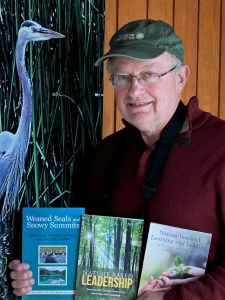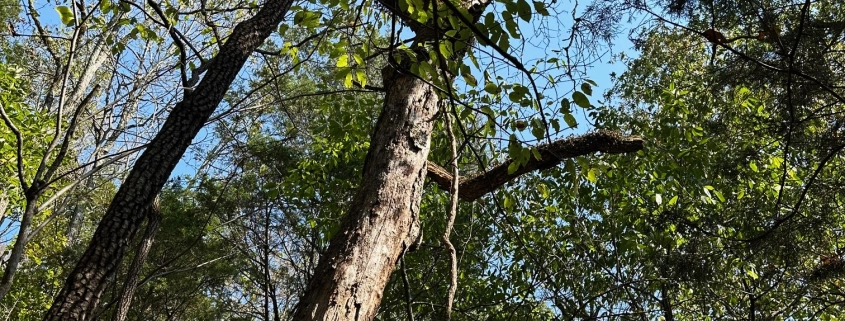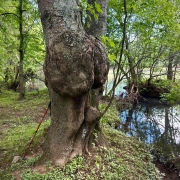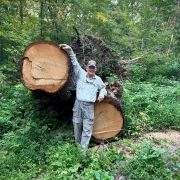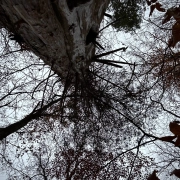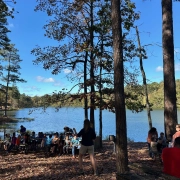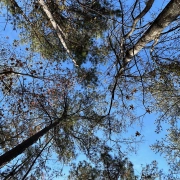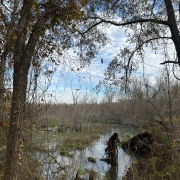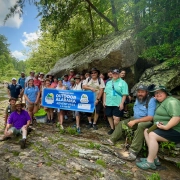First Moderate Hike (Saunter) Since Knee Replacement Surgery: Rainbolt Trail
On Sunday, October 13, 2024, I “co-led” a University of Alabama in Huntsville Osher Lifelong Learning Institute (OLLI) hike on the Rainbow Mountain Nature Preserve in Madison, Alabama. I used the term co-led liberally. I co-chair the OLLI Member Interest Group for hiking and Nature Walks. Just 7.5 weeks past my total right knee replacement surgery, this was my first attempt at a hilly, rocky, and uneven trail designated as moderately difficult. I lagged far behind, returned to the trailhead at the halfway point, and relished this new recovery benchmark!
The fifteen fellow hikers enjoyed the gorgeous weather, wished me well, and hoped I would soon reach the target of again fully participating.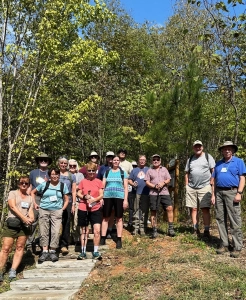
We began at the Rainbolt Trail, a new one-half mile section that meanders approximately 225 feet vertical to the Rainbow Loop Trail atop Rainbow Mountain. I made it nearly to Rainbow Loop. The Rainbolt moniker dates to the original resident, Mr. Rainbolt, his name long since simplified (or bastardized) to Rainbow. Eastern Red Cedar, a common pioneer species, dominates the Preserve’s harsher, drier sites.
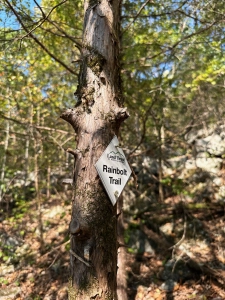
The Hardscrabbled Forest
I puzzled over why Mr. Rainbolt found attraction to this rugged 350-foot monadnock of broken limestone, shallow soils, and mixed forest in the midst of an otherwise rich landscape of verdant valley, fertile farmland, and productive forest. Except for the 147-acre Rainbow Mountain Nature Preserve the surrounding landscape has converted to an expanse of residential and commercial development. The southwest-facing hillside that the Rainbolt Trail ascends is particularly harsh, seasonally parched, and covered by scrubby second- and third-growth forest. Don’t look for towering hardwoods, excepting a few big fellows like the leaning oak below left and an occasional respectable shagbark hickory (right).
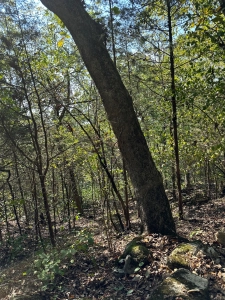
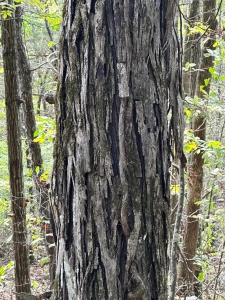
My 59-second video highlighting the scrubby forest:
The trail wanders along limestone ledges and scattered pole-size hardwoods and cedars. Forget about deep shade, cool hollows, and refreshing breezes. Even with most leaves still clinging to the overstory, ample sunshine penetrates to the forest floor. Tree height is the single best indicator of forest site quality, a surrogate for soil moistire, available nutrients, and microclimate.
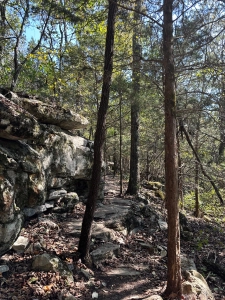
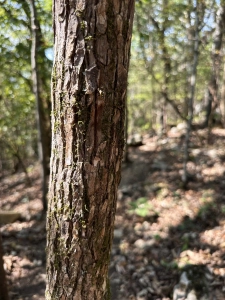
High closed canopies typify rich sites. The dead oak snag at left stands under a large opening. In nearby riparian forests such attrited openings fill rapidly. The same snag rises at left from a rock ledge bulwark. Contrast the apparent depth and extent of soil here to the deep expansive soils in the nearby Tennessee River flood plain. The perpetual process of life and death in the respective forest is integral to both sites, but the pace correlates with fertility.
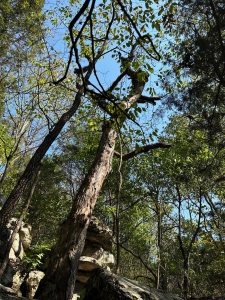
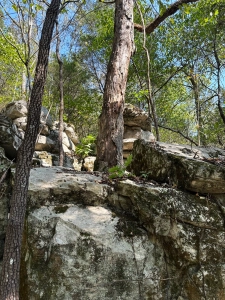
Decay and decomposition perpetuate the carbon cycle, the essentual flow of mass and energy within the forest. Within the Rainbow Mounatain Nature Preserve’s 147 acres, a map of soil site quality, productivity, and the pace of carbon cycling would vary from a low on the W/SW-facing slope where the Rainbolt Trail ascends to the concave lower slope where Rainbow Spring descends to the E/SE. I focused my PhD dissertation on soil-site relationships in the Allegheny hardwood forests of NW PA and SW NY nearly 40 years ago. I am amazed how applicable the findings are across the eastern US mid-lattitudes.
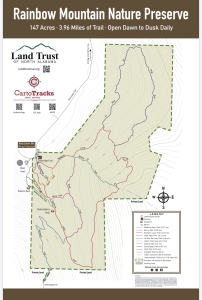
The Rainbolt Trail consistently tells the tale of poor forest productivity.
Here is another 59-second scrub forest video:
The harsh conditions (heat, drought, shallow soils, and westerly wind exposure) do not favor large boles and tall tree growth. A shattered 15-inch-diameter red oak snag and a nearby fallen dead oak of similar size bear testament.
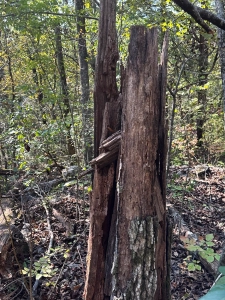
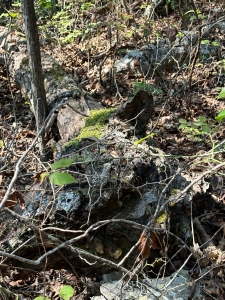
In such a forest, understory stems are often the same age as the main canopy. This three-inch-diameter sapling, deeply hollowed by rot, stood for decades along what a year ago became the new trail. I neglected to examine its wood to identify species. Well, not so much neglected but failed to bring along my pocket knife.
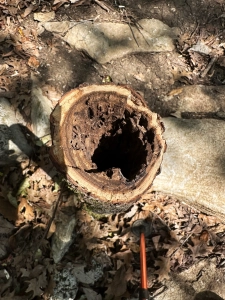
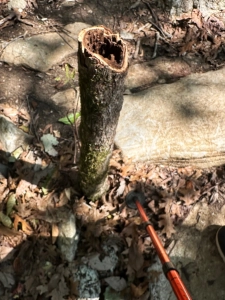
Although I spotted no other evidence of fire history, this charred cedar told the tale of a decades-old event when a westerly wind sent an escaped brush fire upslope, consuming the downed cedar and other brushy debris. When I next traverse the trail I will look for other signs of past burning.

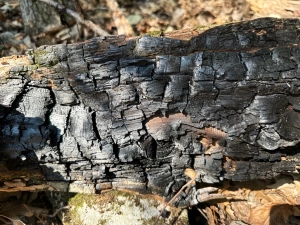
The Preserve has suffered the incidental and intentional abuses of 200 years of human action as the city of Madison slowly encroached what would become the Preserve.
Limestone Mountain Bones
Just as Balance Rock serves as a natural landmark near the Preserve summit, Alligator Rock fulfils the same purpose on Rainbolt Trail, although less prominently and certainly less spectacularly.
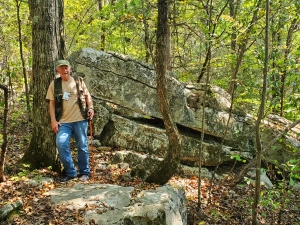
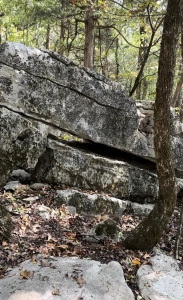
See my 49-second video of Alligator Rock:
Perhaps because my recovery-impaired mobility forced me to pay more attention to nuances of my passage, I noticed a stone visage that no one else has mentioned. I see a sphinx-face or a ram’s head with prominent eye sockets and brows, and a strong collar and powerful neck. Was this a fleeting paranormal wisp that took form beyond just my recovery-induced stress of wandering alone on the trail?!
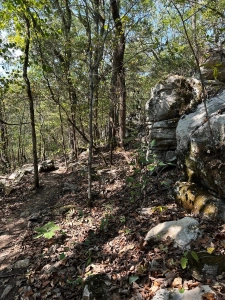
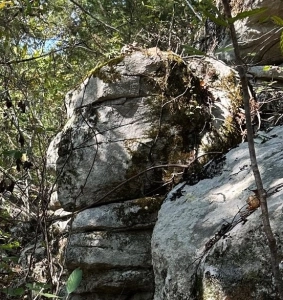
Further below as I descended I saw a bleached catlle skull trailside! Or maybe it’s a piece of weathered limestone. Now that my knees are much better healed, it’s time to retrace the route and test whether the figments (and fragments) remain.
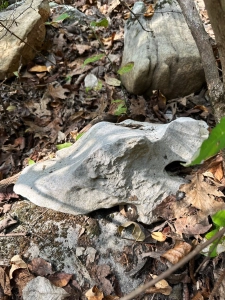
And then there appeared ancient ribbed carcasses. Did Mr. Rainbolt herd poor-site cattle who mineralized on these hardscrabbled, nutrient-poor, moisture-stressed hillside? There are strange tales to be told and relived on the Rainbolt Trail.
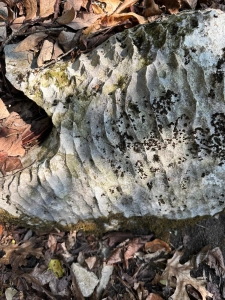
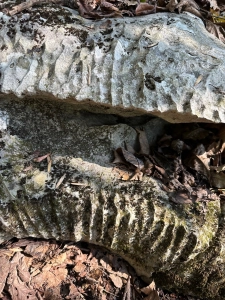
I am a natural resource scientist, securing my PhD in 1987. Over the course of my academic career, I competed successfully for a quarter of a billion dollars in grants and contracts. As Chancellor of the University of Alaska Fairbanks, I led America’s Arctic University’s 3,500 faculty and staff. As Chair of the Governing Board of the University of the Arctic, I led a consortium of 90 high-latitude colleges and universities enrolling more that 700,000 students. As I look back across a fulfilling higher education career, I attribute much of my meager success to good humor, vivid imagination, and not taking myself too seriously, hence the ram’s head, bleached skull, and ribbed carcasses!
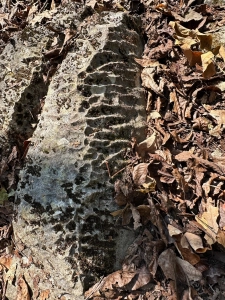
Einstein nailed it:
I am enough of the artist to draw freely upon my imagination. Imagination is more important than knowledge. Knowledge is limited. Imagination encircles the world.
Thoughts and Reflections
I offer these observations:
- The Preserve has suffered the incidental and intentional abuses of 200 years of human action as the city of Madison slowly encroached on what would become the Preserve.
- Except for the 147-acre Rainbow Mountain Nature Preserve, the surrounding landscape has converted to an expanse of residential and commercial development.
- Imagination is more important than knowledge. Knowledge is limited. Imagination encircles the world. (Albert Einstein)
Inhale and absorb Nature’s elixir. May Nature Inspire, Inform, and Reward you!
Note: Unless otherwise noted, all blog post images are created & photographeerved.”
And Third: I am availabd by Stephen B. Jones. Please circulate images with photo credit: “©2024 Steve Jones, Great Blue Heron LLC. All Rights Resle for Nature-Inspired Speaking, Writing, and Consulting — contact me at steve.jones.0524@gmail.com
A reminder of my Personal and Professional Purpose, Passion, and Cause
If only more of us viewed our precious environment through the filters I employ. If only my mission and vision could be multiplied by untold orders of magnitude:
Mission: Employ writing and speaking to educate, inspire, and enable readers and listeners to understand, appreciate, and enjoy Nature… and accept and practice Earth Stewardship.
Vision:
- People of all ages will pay greater attention to and engage more regularly with Nature… and will accept and practice informed and responsible Earth Stewardship.
- They will see their relationship to our natural world with new eyes… and understand their Earth home more clearly.
Tagline/Motto: Steve (Great Blue Heron) encourages and seeks a better tomorrow through Nature-Inspired Living!
Steve’s Four Books
I wrote my books Nature Based Leadership (2016), Nature-Inspired Learning and Leading (2017), Weaned Seals and Snowy Summits: Stories of Passion for Place and Everyday Nature (2019; co-authored with Dr. Jennifer Wilhoit), and Dutton Land & Cattle: A Land Legacy Story (2023) to encourage all citizens to recognize and appreciate that every lesson for living, learning, serving, and leading is either written indelibly in or is powerfully inspired by Nature. All four of my books present compilations of personal experiences expressing my deep passion for Nature. All four books offer observations and reflections on my relationship with the natural world… and the broader implications for society. Order any from your local indie bookstore, or find them on IndieBound or other online sources such as Amazon and LifeRich.
I began writing books and Posts for several reasons:
- I love hiking and exploring Nature
- I see images I want to (and do) capture with my trusty iPhone camera
- I enjoy explaining those images — an educator at heart
- I don’t play golf!
- I do love writing — it’s the hobby I never needed when my career consumed me
- Judy suggested my writing is in large measure my legacy to our two kids, our five grandkids, and all the unborn generations beyond
- And finally, perhaps my books and Blogs could reach beyond family and touch a few other lives… sow some seeds for the future
